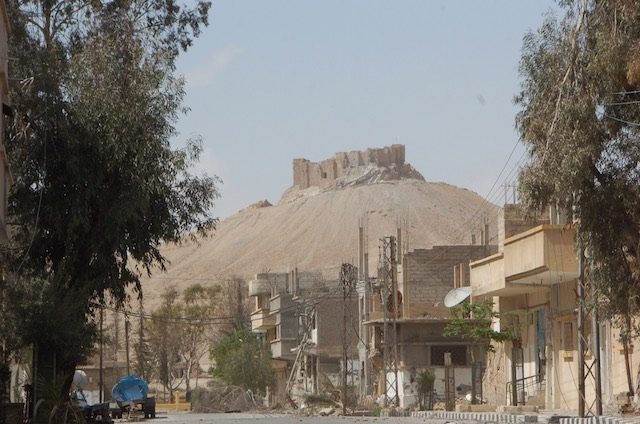SUMMARY
This is AI generated summarization, which may have errors. For context, always refer to the full article.

PALMYRA, Syria – Archaeologists were rushing to the ancient city of Palmyra on Monday, March 28, to assess the damage wreaked by the Islamic State (ISIS) group, after it was ousted by the Syrian army in a bloody battle.
President Bashar al-Assad hailed the victory as “important” as Damascus reportedly dispatched experts to check the damage wreaked by the jihadists on the UNESCO world heritage site.
An Agence France-Presse correspondent inside Palmyra said some monuments, including the iconic Temple of Bel, lay in pieces almost a year after jihadists seized the site, but much of the ancient city was intact.
Residential neighborhoods in the adjacent modern town, where 70,000 people lived before the war, were deserted and damage there was widespread, the correspondent said.
Syrian soldiers, pro-government militiamen and Russian fighters strolled among the ruins in awe after seizing the city on Sunday, March 27, while regime troops kicked around a football in the middle of a street.
ISIS sparked a global outcry when they started destroying Palmyra’s treasured monuments, which they consider idolatrous, after taking the city in May 2015.
Syria’s antiquities chief said the priceless artifacts had survived better than feared from a campaign of destruction UNESCO described as a “war crime”.
“We were expecting the worst. But the landscape, in general, is in good shape,” Maamoun Abdulkarim told Agence France-Presse from Damascus.
“We could have completely lost Palmyra… The joy I feel is indescribable.”
‘Lost to science’
Historian of the ancient world Maurice Sartre told Agence France-Presse that Abdulkarim was already on his way from Damascus to begin a survey of the ruins.
“One mustn’t forget that only around 15 to 20% of Palmyra had actually been excavated, and so there was an enormous amount yet to discover,” he said.
“All the tombs we hadn’t excavated and have now been totally pillaged are lost to science forever.”
ISIS had used Palmyra’s ancient theater as a venue for public executions and also murdered the city’s 82-year-old former antiquities chief.
The Syrian army said the city would now serve as a base to “broaden operations” against ISIS, including in its stronghold of Raqa and Deir Ezzor further east.
At least 400 ISIS fighters were killed in the battle for the city, the Syrian Observatory for Human Rights said. On the government side, 188 troops and militiamen were killed.
“That’s the heaviest losses that [ISIS] has sustained in a single battle since its creation” in 2013, the director of the Britain-based monitoring group, Rami Abdel Rahman, told Agence France-Presse.
The ancient city, northeast of Damascus, drew some 150,000 tourists a year before Syria’s civil war and is known to Syrians as the “Pearl of the Desert”.
Syrian state television broadcast footage from inside Palmyra’s famed museum, showing jagged pieces of sculptures on the ground and blanketed in dust.
Gains against ISIS
ISIS is under growing pressure from Syrian and Iraqi forces determined to retake bastions of its self-proclaimed “caliphate”.
On Thursday, March 24, the Iraqi army announced the launch of an offensive to eventually recapture second city Mosul, held by the jihadists since June 2014.
Russian forces, which intervened in support of longtime ally Assad last September, were heavily involved in the Palmyra offensive despite a major drawdown last week.
Russian warplanes carried out 40 combat sorties around Palmyra in the last 24 hours, striking 117 “terrorist targets” and killing 80 ISIS fighters, Moscow’s defense ministry said Sunday.
Putin telephoned Assad to congratulate the Syrian leader, adding that “successes such as the liberation of Palmyra would be impossible without Russia’s support,” a Kremlin spokesman said.
Assad said the victory was “fresh proof of the efficiency of the Syrian army and its allies in fighting terrorism”.
ISIS and its jihadist rival, the Al-Qaeda-affiliated Al-Nusra Front, are not party to a ceasefire in force across Syria since February 27.
The truce has brought relative quiet to many areas across Syria, where more than 270,000 have been killed and millions had fled their homes in the last 5 years.
The Observatory for Human Rights said on Sunday that 363 civilians had been killed since the truce went into effect – the lowest monthly toll in 4 years. – Maher Al Mounes, AFP / Rappler.com
Add a comment
How does this make you feel?
There are no comments yet. Add your comment to start the conversation.